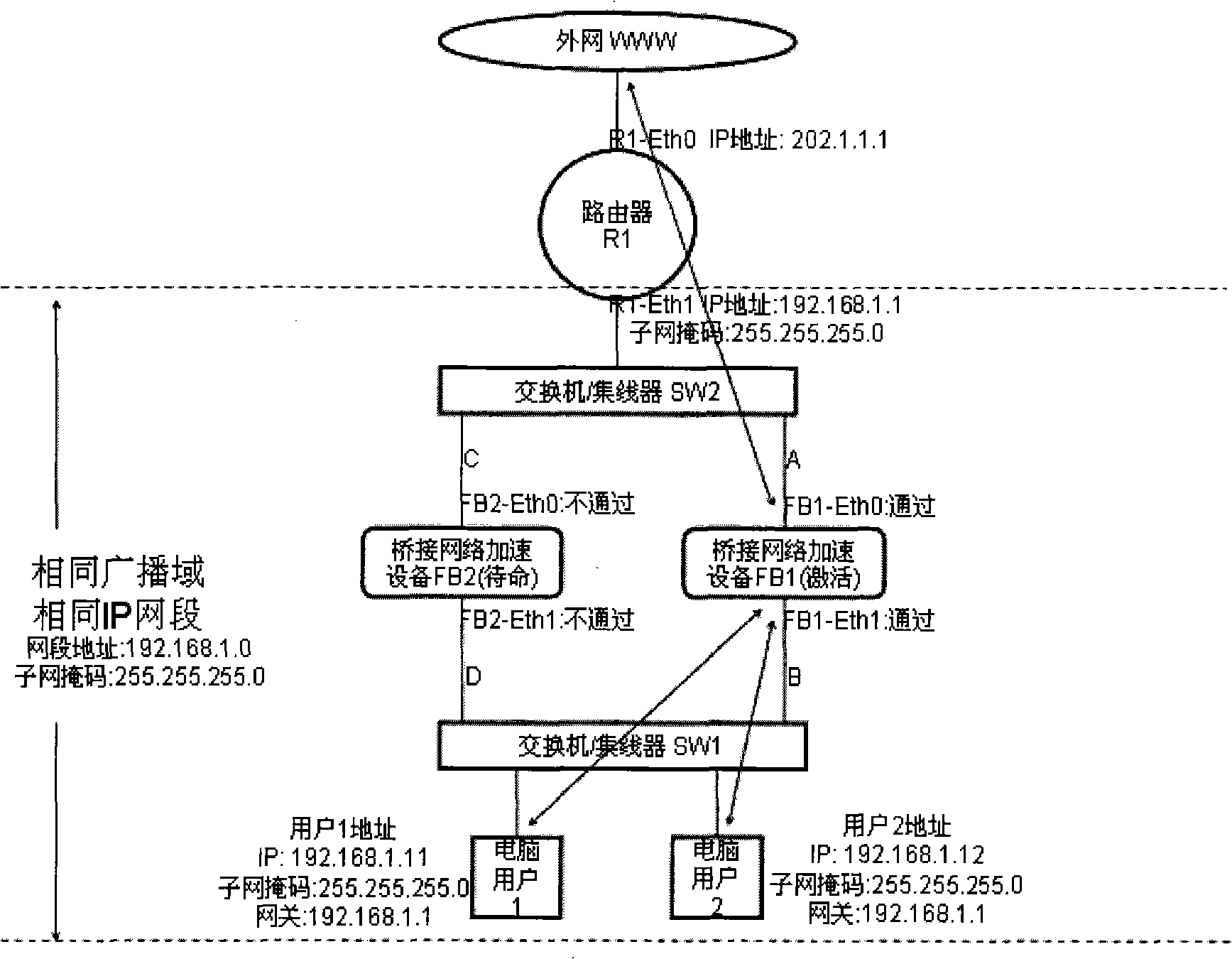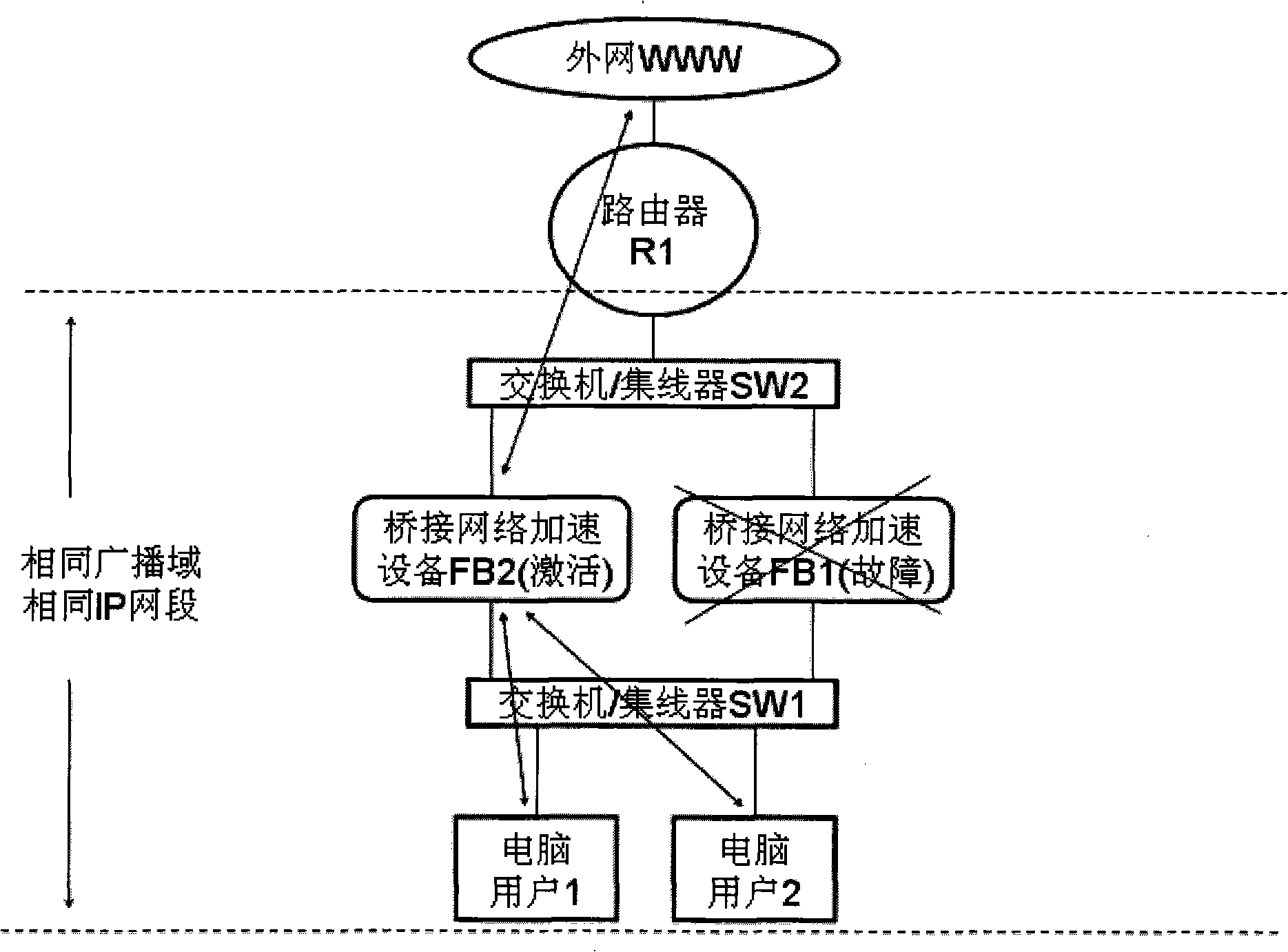Method and system for implementing double-machine hot backup of bridge network accelerating device
A dual-machine hot backup and acceleration device technology, applied in transmission systems, digital transmission systems, electrical components, etc., can solve problems such as network truncation, single point of failure, and inability to connect users to external networks
- Summary
- Abstract
- Description
- Claims
- Application Information
AI Technical Summary
Problems solved by technology
Method used
Image
Examples
Embodiment 1
[0033] As shown in Fig. 2, the present invention is the original main line between router and switch, adds a backup line, and installs a bridging mode network acceleration device FB2 (standby) in this backup line, and the bridging network in the backup line The configuration of the acceleration device and the bridging network acceleration device of the main line can be different. Since the bridge mode network acceleration device FB1 (activation) and the bridge mode network acceleration device FB2 (standby) in the standby line perform hot backup monitoring, when the two paths are normal, the network interface of the bridge network acceleration device FB1 (activation) allows The packet passes, except for the hot backup monitoring communication packet between the two devices, the network interface of the bridging network acceleration device FB2 (standby) blocks other packets to ensure that the backup line from point C to point D is unreachable, and that there is no communication b...
Embodiment 2
[0049] Add a connection line E between the bridged network acceleration devices FB1 and FB2 that realize dual-machine hot backup, and the active state device sends a status briefing to the standby state device on this connection line E, as shown in Figure 6, the bridged network acceleration When the device FB1 is activated, it will check the network status in two directions:
[0050] 1. Send an ICMP request to the uplink router or uplink switch or other IP devices on the uplink or external network websites or other IP devices on the external network on the network port of the uplink remote line A to determine the status of the uplink.
[0051] 1.1 If the ICMP response from the upstream device is received within the specified time, FB1 remains active.
[0052] 1.2 If there is no ICMP response from the uplink device within the specified time, FB1 determines that there is a fault between the uplink remote line A and the uplink device (as shown in Figure 7), and immediately connec...
Embodiment 3
[0070] In Embodiment 3, the 802.3ad (LACP) multi-link aggregation (accompanying drawing 10) must be started on the upstream router or the upstream switch and the downstream router or the downstream switch, and when the bridging network acceleration device is connected, there is a connection line E between FB1 and FB2 , FB1 and FB2 send a status briefing on the E line, and the E line is also a data backup line. The two physical devices FB1 and FB2 will form a virtual bridge network acceleration device, and the virtual bridge network acceleration device will start 802.3ad (LACP) multi-chain The road aggregation protocol is connected to the upstream device and the downstream device (Fig. 11), and the traffic can be accelerated through FB1 or FB2 at the same time (Fig. 12).
[0071] 1. When the uplink A fails:
[0072] 1.1 FB1 detects the failure of the uplink A network port, FB1 sends an uplink path failure report to FB2, and changes the traffic channel of the uplink A network po...
PUM
 Login to View More
Login to View More Abstract
Description
Claims
Application Information
 Login to View More
Login to View More - R&D
- Intellectual Property
- Life Sciences
- Materials
- Tech Scout
- Unparalleled Data Quality
- Higher Quality Content
- 60% Fewer Hallucinations
Browse by: Latest US Patents, China's latest patents, Technical Efficacy Thesaurus, Application Domain, Technology Topic, Popular Technical Reports.
© 2025 PatSnap. All rights reserved.Legal|Privacy policy|Modern Slavery Act Transparency Statement|Sitemap|About US| Contact US: help@patsnap.com



